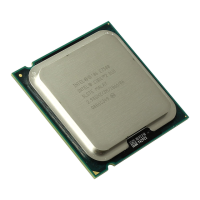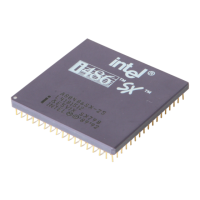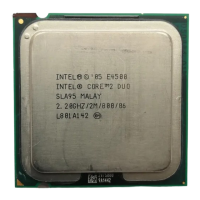Intel
®
Core
TM
2 Duo E6400, E4300, and Intel
®
Pentium
®
Dual-Core E2160 Processor
October 2007 TDG
Order Number: 315279 -003US 13
Processor Thermal/Mechanical Information—Intel
®
Core
TM
2 Duo E6400, E4300, and Intel
®
Pentium
®
Dual-Core E2160 Processor
• Ensuring thermal performance of the thermal interface material (TIM) applied
between the IHS and the heatsink. TIMs based on phase change materials are very
sensitive to applied pressure: the higher the pressure, the better the initial
performance. TIMs, such as thermal greases, are not as sensitive to applied
pressure. Designs should consider a possible decrease in applied pressure over
time due to potential structural relaxation in retention components.
• Ensuring system electrical, thermal and structural integrity under shock and
vibration events. The mechanical requirements of the heatsink attach mechanism
depend on the mass of the heatsink and the level of shock and vibration that the
system must support. The overall structural design of the motherboard and the
system have to be considered when designing the heatsink attach mechanism.
Their design should provide a means for protecting LGA775 socket solder joints.
One of the strategies for mechanical protection of the socket is to use a preload and
high stiffness clip. This strategy is implemented by the reference design and
described in this document.
Note: Package pull-out during mechanical shock and vibration is constrained by the LGA775
socket load plate (refer to the LGA775 Socket Mechanical Design Guide for more
information).
2.1.2.2 Heatsink Clip Load Requirement
The attach mechanism for the heatsink developed to support the processor should
create a static preload on the package between 18 lbf and 70 lbf throughout the life of
the product for designs compliant with the Intel reference design assumption:
• 72 mm x 72 mm mounting hole span (refer to Figure 20)
The minimum load is required to protect against fatigue failure of socket solder joint in
temperature cycling.
It is important to take into account potential load degradation from creep over time
when designing the clip and fastener to the required minimum load. This means that,
depending on clip stiffness, the initial preload at beginning of life of the product may be
significantly higher than the minimum preload that must be met throughout the life of
the product. For additional guidelines on mechanical design, in particular on designs
departing from the reference design assumptions, refer to Appendix A.
For information on Clip loading, refer to the Intel® Core™2 Duo Desktop Processor
E6000? Sequence Thermal and Mechanical Design Guidelines Supporting the Intel®
Core™2 Duo desktop processor E6000 Sequence.
2.1.2.3 Additional Guidelines
In addition to the general guidelines given above, the heatsink attach mechanism for
the processor should be designed to the following guidelines:
• Holds the heatsink in place under mechanical shock and vibration events and
applies force to the heatsink base to maintain desired pressure on the thermal
interface material. Note that the load applied by the heatsink attach mechanism
must comply with the package specifications described in the processor datasheet.
One of the key design parameters is the height of the top surface of the processor
IHS above the motherboard. The IHS height from the top of board is expected to
vary from 7.517 mm to 8.167 mm. This data is provided for information only, and
should be derived from:
— The height of the socket seating plane above the motherboard after reflow,
given in the LGA775 Socket Mechanical Design Guide with its tolerances.

